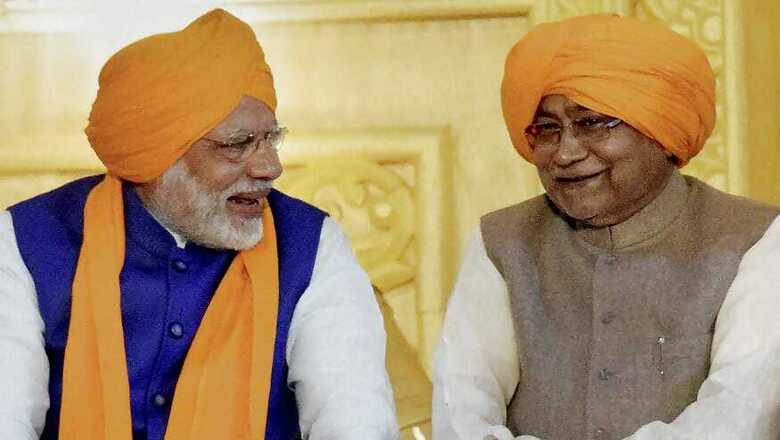
views
Seldom is a sitting chief minister obsessed about his electoral prospects barely 20 months into the government.Even more so when the CM enjoys a comfortable majority in this day and age of fragmented politics.
But Bihar Chief Minister Nitish Kumar is known to buck the trend. The past 20 months have been tumultuous for Kumar, who recently dumped the secular but ‘tainted’ Lalu Yadav to embrace the ‘communal’ BJP.
Working with the BJP is not new for Kumar. Both had worked together for 17 long years till June 2013, when Kumar unilaterally announced a split with the saffron organisation in Bihar and walked out of the National Democratic Alliance (NDA).
But the ground realities have changed irrevocably since then, thanks to the shifting political alignments in Bihar amid barbs of rank opportunism and craven lust for power.
Now, the BJP, under Narendra Modi and Amit Shah, is a different proposition for Kumar. Ditto for the cornered Rashtriya Janata Dal, which now has young and aggressive duo of Tejashwi Yadav and Tej Pratap at the helm of the party affairs.
With this backdrop, why would Kumar want to advance assembly polls coinciding with the next Lok Sabha elections? And that too a good one-and-a-half years before the term of the current government ends in November 2020.
The reasons are varied, according to political analysts in Delhi and Patna.
First, what a force multiplier Nitish Kumar and Narendra Modi would become when they share the stage to seek another term for themselves as Chief Minister and Prime Minister, respectively. All empirical evidences so far suggest that the Modi wave is here to stay as it was during the last Lok Sabha polls and Kumar would love to ride the Modi wave to his advantage.
Second, the RJD leadership has gone to town with accusations that Kumar ditched the secular alliance and that the 2015 mandate was against the BJP. Lalu and his two MLA sons — Tej Pratap and Tejashwi Prasad Yadav — are upping the ante with a series of rallies and yatras, claiming to ‘expose’ Kumar’s duplicity and betrayal. These charges are an antithesis to what Kumar stands for and is keen to deflect the vicious attacks targeting him.
Add to it a sulking and bellicose Sharad Yadav, who is looking for an opening to embarrass Kumar.
The Bihar Chief Minister would also want to cash in on the usual trend of the electorate voting for the same party for both in assembly and Parliamentary elections. If the voters’ pick is Modi for a second consecutive term, Kumar too may get to enjoy the electorates’ benevolence.
Besides, snap polls could help Kumar further consolidate his pet Mahadalit – the poorest among the Dalits — vote bank, which is being incessantly courted by the RJD and the BJP. Mahadalits account for about 13% of votes in Bihar.
The other factor that may work for Kumar-led JD(U) is the aggressive and at times violent posturing by RJD workers to oppose the CM’s ‘betrayal’.
The non-Yadav backwards and a section of have-nots among Muslims who have traditionally voted for him are wary of RJD’s perceived hegemony and may perhaps throw their lot behind Kumar more strongly than ever.
And much to Kumar’s advantage Lalu Yadav’s vote bank has remained stagnant. The RJD chief had always enjoyed support from Yadavs and Muslims (M-Y), but other caste groupings have seldom been loyal to the maverick leader, whose electoral career has been cut short because of conviction in the fodder scam. This electoral arithmetic may remain intact as no other caste group is aligning with the M-Y combination.
The BJP may get to actively woo Muslim women voters after the Supreme Court verdict on the triple-talaq issue. The pro-Hindutva party’s play for Muslim women votes may further emasculate Lalu Yadav, and this could emerge as a win-win situation for Kumar.
The Bihar CM’s welfare schemes for girl students like free education and distribution of bicycles and uniforms too would pass the electoral muster again. Liquor ban has further consolidated his hold on hapless women voters.
In fine, Kumar is known for riding coalition of extremes with aplomb. On one side, he enjoys the support of poorest of the poor, and on the other he’s backed by social haves. Never before two such extremes of social strata have come together with such an ease under a single umbrella behind a single regional leader.
What appears an invincible combination on paper could well evolve into a political reality. And Kumar could go down in history as the most astute master of social engineering to reap a massive political dividend.




















Comments
0 comment